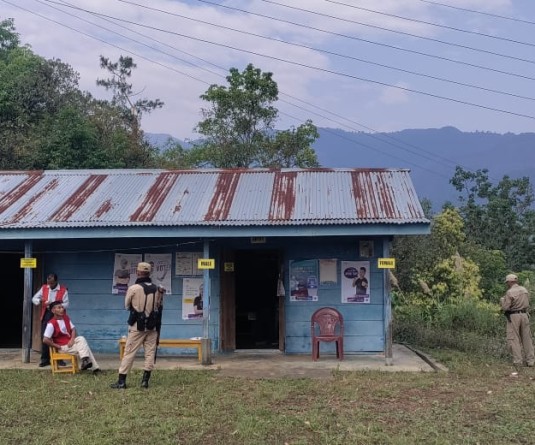
Romanian medical students dance during a flash mob event to raise awareness to the risk of being infected with the HIV virus, at the main railway station in Bucharest, Romania, Wednesday, Nov. 30, 2011, one day ahead of World AIDS Day on Dec. 1. (AP Photo)
Geneva, November 30 (AGENCIES): For the first time since the AIDS virus was discovered 30 years ago and 34 million people around the world live with HIV infection, the World Health Organization has announced good news: Improved access to condoms, medical services and treatment have reduced by 15 percent the number of new infections in a decade and AIDS-related deaths by 22% in the last five years.
Gottfried Hirnschall, director of WHO’s HIV department in Geneva, said Wednesday that “it has taken the world 10 years to achieve this level of momentum. There is now a very real possibility of getting ahead of the epidemic. But this can only be achieved by both sustaining and accelerating this momentum over the next decade and beyond.” World AIDS Day is on December 1.
Improved access to HIV testing services enabled 61% of pregnant women in eastern and southern Africa to receive HIV testing and counseling, which is a significant increase from the 14% it was in 2005. Almost half of pregnant women in need receive effective medicines to prevent mother-to-child transmission of HIV. Antiretroviral therapy, which not only improves the health and well-being of the infected people but also stops further HIV transmission, is available now for 6.65 million people in low- and middle-income countries, accounting for 47% of the 14.2 million people eligible to receive it.
It has been “a game-changing year,” said Paul De Lay, deputy executive director, of UNAIDS. “With new science, unprecedented political leadership and continued progress in the AIDS response, countries have a window of opportunity to seize this momentum and take their responses to the next level. By investing wisely, countries can increase efficiencies, reduce costs and improve on results. However, gains made to date are being threatened by a decline in resources for AIDS,” he warned.
The report also points to what still needs to be done: More than half of the people who need antiretroviral therapy in low- and middle-income countries are still unable to access it. Many of them do not even know that they have HIV.
Worldwide, women are the main sufferers, as they constitute 64% of people aged 15 to 24 living with HIV today, according to the WHO. Although better services to prevent mother to child transmission of HIV have averted some 350,000 new infections among children, some 3.4 million of them have been infected.
Asia shows a stabilizing epidemic overall, but new infections are very high in some communities. Of the 4.8 million people living with HIV in Asia, nearly half are in India. Eastern Europe and Central Asia show dramatic growth in HIV, with new infections increasing by 250% in the past decade; over 90% of these infections occur in Russia and Ukraine alone. The Middle East and North Africa had the highest number of HIV infections ever in the region (59,000) last year.
Gottfried Hirnschall, director of WHO’s HIV department in Geneva, said Wednesday that “it has taken the world 10 years to achieve this level of momentum. There is now a very real possibility of getting ahead of the epidemic. But this can only be achieved by both sustaining and accelerating this momentum over the next decade and beyond.” World AIDS Day is on December 1.
Improved access to HIV testing services enabled 61% of pregnant women in eastern and southern Africa to receive HIV testing and counseling, which is a significant increase from the 14% it was in 2005. Almost half of pregnant women in need receive effective medicines to prevent mother-to-child transmission of HIV. Antiretroviral therapy, which not only improves the health and well-being of the infected people but also stops further HIV transmission, is available now for 6.65 million people in low- and middle-income countries, accounting for 47% of the 14.2 million people eligible to receive it.
It has been “a game-changing year,” said Paul De Lay, deputy executive director, of UNAIDS. “With new science, unprecedented political leadership and continued progress in the AIDS response, countries have a window of opportunity to seize this momentum and take their responses to the next level. By investing wisely, countries can increase efficiencies, reduce costs and improve on results. However, gains made to date are being threatened by a decline in resources for AIDS,” he warned.
The report also points to what still needs to be done: More than half of the people who need antiretroviral therapy in low- and middle-income countries are still unable to access it. Many of them do not even know that they have HIV.
Worldwide, women are the main sufferers, as they constitute 64% of people aged 15 to 24 living with HIV today, according to the WHO. Although better services to prevent mother to child transmission of HIV have averted some 350,000 new infections among children, some 3.4 million of them have been infected.
Asia shows a stabilizing epidemic overall, but new infections are very high in some communities. Of the 4.8 million people living with HIV in Asia, nearly half are in India. Eastern Europe and Central Asia show dramatic growth in HIV, with new infections increasing by 250% in the past decade; over 90% of these infections occur in Russia and Ukraine alone. The Middle East and North Africa had the highest number of HIV infections ever in the region (59,000) last year.




